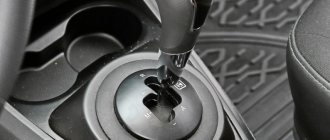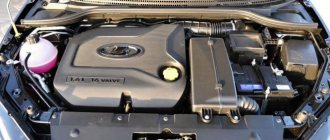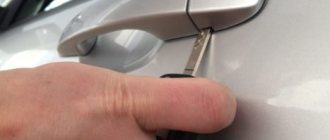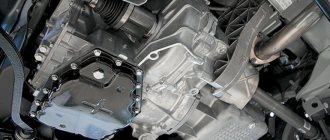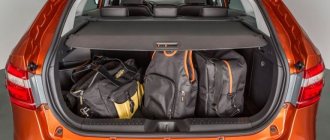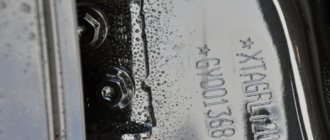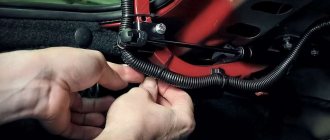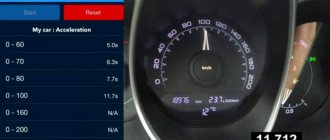AVTOVAZ assures that today’s Lada body is a modern high-tech product, sufficiently protected and always ready for use in our harsh road and climatic conditions. Is this really so? We decided to analyze owner reviews to determine how quickly rust appears on the Lada Vesta body.
How the new Lada Vesta is protected from corrosion
The car body is made of galvanized steel. A cataphoresis primer is applied under the paint layer. The coating is resistant to mechanical stress. The cavities and recesses are treated with an oil-wax composition to prevent corrosion. The bottom and chassis elements are coated with a product that is resistant to humidity and temperature changes.
Checking Vesta for corrosion. Photo source: pikabu.ru
But Lada Vesta has problem areas that require corrosion treatment:
- Too thin a layer of mastic on the bottom, uneven application.
- The gaps at the joints of the body parts were treated with Movil with smudges, unevenly.
- Poor treatment with the compound in the area where the air conditioner breather exits.
- There is no anti-corrosion treatment at the junction of the trunk and rear side member.
- The rear arches do not have lockers, moisture and dirt accumulate on the metal surface.
- The plastic does not fit tightly to the front fender, allowing water to enter the cavity.
- There is no anticorrosive in the upper part of the hood, as well as on the lock.
- The door seal closes the drainage holes, moisture accumulates on the thresholds.
- A very thin layer of protective mastic in the trunk cavities.
The car's protection is no worse than that of its competitors. But it is advisable to additionally treat critical surfaces of the Lada Vesta with an anti-corrosion compound.
What do we end up with?
The developers kept their promises, because the body turned out to be really strong. A six-year warranty, instead of the promised five-year period, became a balm for the soul of the owners. This figure is not impressive when compared with the warranty periods that foreign manufacturers provide for their models.
So is the body galvanized? Yes! There is galvanization, and the thickness of the metal is quite good! But for some reason the manufacturer uses the most “budget” method of applying such a coating. Body elements are processed only from the outside, with the exception of the bottom, which is coated on both sides. Another feature is that instead of liquid zinc, the plant uses the substance in powder form. This allows you to better process not only the cracks, but also all the bends present in the body. The thickness of the formed zinc layer reaches 8 microns, which was taken into account when calculating the warranty period.
Interesting! In the history of domestic serial production of cars, the Lada Vesta model was the first to receive zinc treatment of the body, with the exception of the roof surface.
Wanting to provide adequate protection for the body of his brainchild, the manufacturer focused on cataphoresis primer. The essence of the process is to immerse the body frame in a special container. The anode electrode is connected to the body itself, and the so-called cathode is connected to the bath. This procedure allows the positively charged soil to settle on the surface of the metal, which has a negative charge. Thus, the metal surface is covered with an appropriate film, which subsequently has a protective function.
The main places where rust appears on Vesta
Owners of Lada Vesta usually pay attention to the external manifestation of corrosion. But there are many hidden cavities and passages in the car where rust can appear. Standard processing does not last forever and requires periodic updating. The underside of the vehicle is subject to wear and tear due to ingress of solid particles. Additionally, reagents together with moisture can accelerate corrosion.
Corrosion on Vesta. Photo source: olade.ru
Surfaces where Lada Vesta rots:
- hidden body niches;
- uneven welds;
- ceiling steel panels;
- drainage holes;
- gaps under plastic linings;
- areas of body paint damage.
The state of protection of external parts can be assessed visually. A borescope is used to check the general condition of the cavity lining. To inspect the anti-corrosion coating, an ultrasonic thickness gauge is used, or, less commonly, a spark flaw detector.
Why is galvanization needed, and what are its types?
The paintwork does not provide a 100% guarantee against the occurrence of corrosion on the body metal. The smallest damage to the coating provokes the penetration of moisture, which, settling on the metal, creates the risk of “red disease”. This factor eventually causes the need for repairs, which is very expensive.
World leaders in the automotive industry have long introduced the practice of galvanizing bodies, thanks to which they can give their customers a long-term guarantee. Is Vesta’s body galvanized?
Body panels can be galvanized by implementing the following methods:
- heat treatment;
- galvanic galvanizing method;
- cold method.
With the thermal method of implementing the technology, the body is completely immersed in a solution with a special composition. Then the container is heated to a certain temperature parameter. This is a very effective method that manufacturers use during the production of expensive premium models.
During galvanic treatment, a zinc composition is applied to body elements. This is done through electrolysis. The body component or the entire frame is immersed in a zinc solution and exposed to electricity. The method is not characterized by reliability, but its cost is quite low.
Interesting! The duration of the warranty is directly influenced by the galvanizing method and the resulting thickness of the coating.
The cold working method involves applying zinc-containing primer to body elements. In this case, no manufacturer will provide a long-term warranty, since there is a high probability of damage to the zinc layer along with the outer paintwork.
Why does Lada Vesta rust?
New Lada Vesta cars have good anti-corrosion protection from the factory. But car owners sometimes notice signs of rust. Signs of corrosion are found even in a new car - on the suspension, in the gas removal system. Rust on Vesta appears on uneven weld seams in which dirt accumulates.
This is how the Lada begins to rust. Photo source: youtube.com
The main cause of corrosion is the accumulation of dirt and water in hidden body cavities. These parts are not well treated with protective mastic. Under the influence of reagents, rust occurs very quickly, capturing adjacent areas of the surface. Uneven application of the protective coating also leads to the appearance of pockets of corrosion.
Is rust on Vesta covered under warranty?
The Lada Vesta manufacturer assumes certain obligations in the event of corrosion defects being detected. The car owner needs to have completed Lada Vesta coating inspection coupons in the service book. These marks must be entered after the sale in the showroom and then annually throughout the warranty period. The absence of the required document leads to refusal of repair work when corrosion occurs.
The plant provides a 6-year warranty on galvanized surfaces. Car dealers may provide additional benefits to buyers. When the first signs of corrosion appear, the owner of the Lada Vesta needs to contact a service center to repair the damage.
How to protect Lada Vesta from rust
Anti-corrosion treatment extends the service life of the vehicle. This work is carried out as the protective mastic wears out. Corrosion manifests itself faster due to unfavorable climatic conditions and low-quality cheap protection materials. A rusty Lada Vesta can be restored using special protective compounds.
Additional factory anti-corrosion treatment
AvtoVAZ, in the interests of customers, applies additional corrosion protection. Factory processing locations:
- cavity near the scutes;
- the space between the shock absorber mount and the wheel arch;
- hidden space near the side members;
- cavity behind the sidewall trim;
- junction of the sill trim;
- cavity in the floor under the rear seat;
- luggage lid panels;
- cavities in door openings;
- hood panels.
In addition to the indicated places, the factory additionally processes body fasteners, holes and surface joints.
Processing in a car service
Good quality anti-corrosion protection can be provided by specialists involved in maintenance of Lada Vesta Cross, SW and sedan. Before treatment, the exterior and hidden cavities of the vehicle are thoroughly washed to remove dirt. Dry the car until moisture is completely removed from the surface.
Fret processing. Photo source: 37autoservis.ru
Procedure for applying anti-corrosion protection:
- Installing the car on a lift.
- Dismantling of plastic linings and protective aprons, seals.
- Dismantling the trunk trim, cleaning the cavity with a vacuum cleaner from debris and dirt.
- Cleaning rotten areas of the body. Treatment with primary anti-corrosion primer.
- Placing the car in a special chamber for spraying anticorrosive. Removing wheels. Installing covers on drive mechanisms, hoses and electrical wiring harnesses.
- Spraying an anti-corrosion agent onto the surface. Treatment of hidden cavities with a spray gun according to the manual scheme.
- Cleaning fresh compound from paintwork and plastic parts. Assembly of wheels, protective linings and seals.
- Dry the composition for 3-5 hours at room temperature.
When the protection dries, the car must not be moved. The thickness of the layer of applied composition is checked with a thickness gauge.
Do-it-yourself Vesta protection from corrosion
The car usually does not need additional rust treatment for the first 3 years. But it is better to check the condition of the coating annually. Protective compounds for metal surfaces:
- Underbody materials with gravel protection function. The composition must contain inhibitors and have noise-absorbing properties. Bitumen mastic with filler is suitable for this.
- The anti-corrosion composition of the wheel arch coating must be resistant to abrasive wear of the surface. A “liquid locker” or applying bitumen mastic in 2-3 layers is suitable for processing.
- Treatment of hidden cavities is carried out with liquid anticorrosive agent. The composition effectively displaces moisture and forms a dense film on the metal.
The use of high-quality compounds will protect the car from rust for 2-3 years.
As it was before
For many years, Zhigulis were primed using long-outdated technology, by anaphoresis treatment or anodic deposition. Moreover, even at the time Fiat built the plant in Togliatti, it was not the most modern, but the Italians did not sell their latest developments. And until 1978, they used imported components, until the USSR learned to make the necessary chemical compositions on their own.
Over time, the plant made a big breakthrough in this area. New equipment was purchased; instead of ordinary metal (only with primer), they began to use galvanized metal. In particular, as stated, on the “ten” (VAZ-2110) the number of such body elements is 30-50%, depending on the year of manufacture. For Priora and Kalina, this percentage reaches 70.
Since 1988, VAZ began to paint bodies, including metallic ones. Previously, this option was not available.
One way or another, the opinion has become firmly established among car enthusiasts that VAZs definitely need to be additionally “anti-bark,” that is, the body must be treated in addition to the factory one. Otherwise, even with careful use, the car will become covered with unpleasant red spots, and then completely rot very quickly. This especially applies to Moscow, where in winter a huge amount of chemical reagents are poured onto the streets, which, in addition to their direct task (fighting asphalt icing), literally corrode automobile metal.
What can you do to prevent measles?
Some people order the necessary operation at a service station (official, universal, or even a garage), other owners of Lada cars do not trust the craftsmen and prefer to do everything themselves, thus saving money on paying for the work - after all, you only need to purchase materials.
You will find an overview of the characteristics and features of the Singulato iS6 Electric SUV here.
The most common compositions:
- various types of Movils. There are a huge number of manufacturers, even the verb “zamovilit” (process with Movil) has appeared;
- Body mastics. The number indicates the differences in the specific composition;
- cannon lard (an inexpensive and extremely popular petroleum-based lubricant that has water-repellent and preservative properties).
As for frequency, this is up to the owner of the car. Some people are not lazy to go over the body once a year, others process it every two or three years, or even less often.
You will find the test results of various anticorrosives in this video:
Choice of anticorrosive: compositions and prices
There are a lot of rust protection methods - from simple products to expensive imported mastics:
- Anticorrosive on Vesta is prepared with your own hands from “Gun Lard” and “Cordon” mastic. The total cost of the mixture is about 400 rubles per 1 kg. The product is applied to the surface with a brush.
- The product “Reduced lead ship” covers the surface with an oxide film. Price – 400 rubles per jar.
- Universal “Glue 88” is applied to a degreased surface. The water-repellent film reliably protects metal parts. The cost of glue is up to 400 rubles per package.
- Dinitrol sealant contains inhibitors and anti-gravel additives. Mastic has noise insulating properties. Packaging price – 1150 rubles.
- Anticorrosive Hi Gear contains rubber filler and additives that neutralize road reagents. Cost up to 400 rubles.
- The protective coating "Noksidol" is universal, also suitable for treating hidden cavities. The price of the package is about 700 rubles.
- LIQUI MOLY anti-corrosion agent is used even for old cars. Double application of mastic reliably protects against rust. The cost of the can is less than 500 rubles.
- Liquid Supra Shield easily penetrates into hidden cavities, displaces water and forms a durable protective film. The price of anticorrosive agent is low - 200 rubles per liter.
When choosing protection, it is necessary, in addition to the cost of the product, to take into account the condition of the surface.

